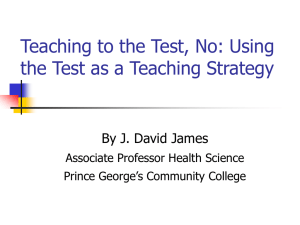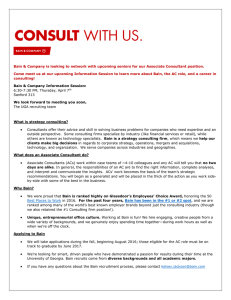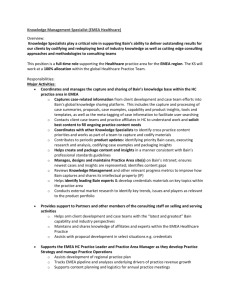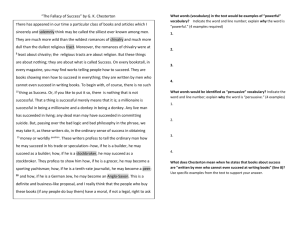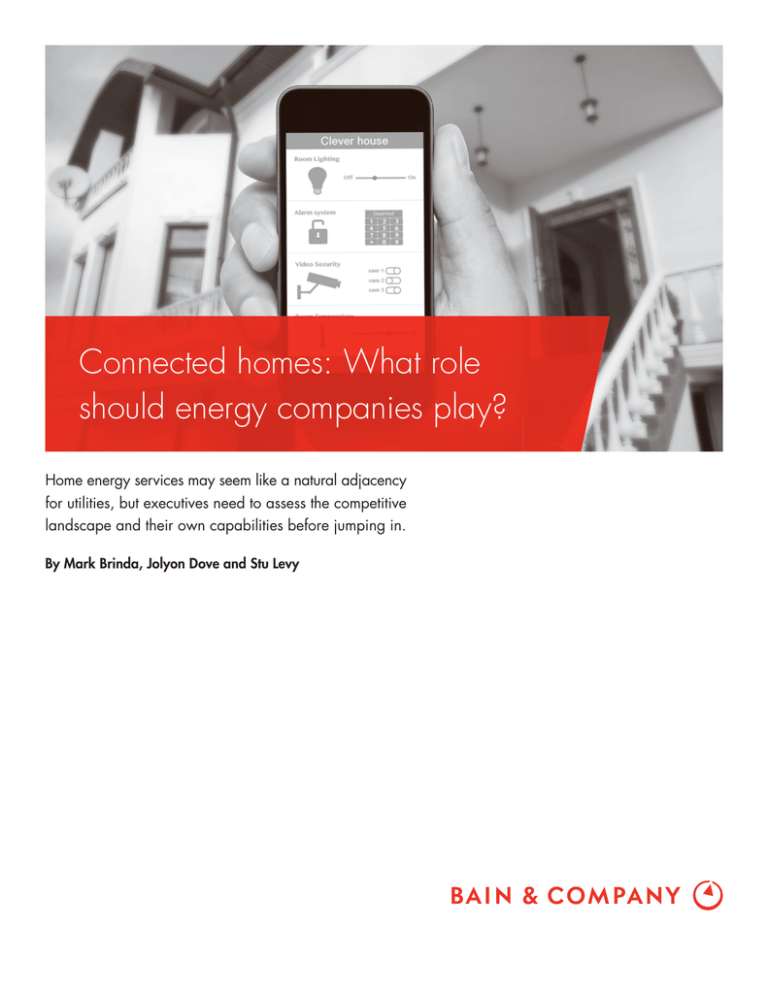
Connected homes: What role
should energy companies play?
Home energy services may seem like a natural adjacency
for utilities, but executives need to assess the competitive
landscape and their own capabilities before jumping in.
By Mark Brinda, Jolyon Dove and Stu Levy
Mark Brinda is a partner with Bain & Company in New York. Jolyon Dove is
a Bain partner in London, and Stu Levy is a partner based in Washington, DC.
All three work with Bain’s Global Utilities practice.
Copyright © 2014 Bain & Company, Inc. All rights reserved.
Connected homes: What role should energy companies play?
What is the role for energy companies in the rapidly
developing market for smart and connected homes? With
many cable, telecom and home security companies offering smart thermostats and plugs as part of a bundle
of connected home services, it’s a logical question for
energy executives to ask. Add to that Google’s acquisition
of Nest for $3.2 billion in January, and the potential of
energy services in the connected home appears that
much more attractive. But are energy providers in the
best position to offer them?
There are also recurring costs to support the added
products and services.
In the US, cable, telecom and home security companies
have taken an early lead in shaping the market by offering connected home bundles that typically build off a
common platform to provide basic security services.
Companies then add other features like remote lighting,
lock controls and carbon monoxide monitoring. This was
a natural progression in their continued search for additional recurring monthly revenue (see Figure 1). Many
have also partnered with technology companies to add
energy management services, including smart thermostats—a possible barrier to energy providers that might
want to partner with them. For example, Time Warner
Cable partnered with tech start-up iControl Networks in
2012 to offer its IntelligentHome service.
Many executives at energy providers are wrestling with
this question, both at traditionally integrated and regulated utilities and at competitive energy marketers.
Unfortunately, there isn’t one right answer. A range of
factors, from the regulatory environment to the existing
competitive landscape, will shape the answer. There are
good reasons to enter the market. In addition to the
recurring revenue from services like remote control and
monitoring, offering these services can improve a company’s brand, set it apart from competitors and even
reduce customer acquisition costs and churn rates—
particularly valuable in competitive markets. Over time,
markets may even see a reduction in wholesale energy
costs if customers begin to shift their use from peak to
off-peak times.
Bundling also allows these companies to spread costs
across a broad set of offerings and adjust pricing to make
energy management essentially free, if necessary, to
compete with standalone offers. These providers can
also justify a greater investment in sales, technology and
service centers, since most operate across numerous
states and have much larger overall customer bases than
many energy providers.
In the UK, utilities may have a better opportunity to
shape the market. Regulators have mandated a national
rollout of smart meters, and now utilities are developing
services that build on them. For example, British Gas is
promoting time-of-use tariffs and remote control services
that let customers adjust their home heating system
remotely—for example, to lower the temperature if
you forgot to do so before leaving. Operators of distribution grids in the UK are considering demand-response
services that reward customers if they reduce their power use during peak periods. For these companies, it may
be less expensive to develop and offer that service than
to build more power distribution capacity.
The decision of whether to enter the
connected home market—and how—
must be based on clear-eyed analysis
of the costs and benefits.
But the decision of whether to enter the connected home
market—and how—must be based on clear-eyed analysis
of the costs and benefits of developing a new and differentiated offering, convincing customers to try it and
keeping them engaged long enough to recoup the initial
investment and generate a profit. Executives should
recognize the significant up-front costs for developing
a technology platform and integrating it with the current
business, as well as for sales, marketing and installation.
In the rest of Europe, utilities may have an even greater
opportunity to shape the market, as the nontraditional
players that have defined it elsewhere have been slow
to enter this region. But as US companies move into
European markets, that is likely to change quickly. Nest
1
Connected homes: What role should energy companies play?
Figure 1: The connected home market has evolved from communications to energy services and beyond
Video and satellite
1
DVR and
on-demand service
Basic programming
Health
Control & monitoring
(e.g., smart thermostats)
Reporting & recommendations
Voice service
2
...adding energy
services to expand
their bundled services
Energy marketer
Energy
Communications
Internet service
Connected
home
Energy-related services
Utility
Cable and telecom
companies attacked
each other’s core...
HS&A pursued energy services to
expand automation, control focus
and find new revenue
3a
3b
...then sought
growth in
automation and other
home controls...
Home security
and automation
Energy offerings with capabilities shared with other connected home products
Note: HS&A is home security and automation
Source: Bain & Company
is among those eyeing the region: The company added
time zones and weather information for 10 European
countries in its January 2014 software upgrade. We see
several ways these nascent markets could evolve, from
simple metering services into full home automation,
depending in part on who takes the lead to define the
early offerings (see Figure 2).
will require significant effort to design and implement
the right product and service offering and to distribute it
through effective sales channels. Because market conditions influence a provider’s ability to enter and play,
executives thinking about competing in energy management or broader connected home services should
consider how the market is already meeting those needs
in their region, what services are gaining traction and
the regulatory environment.
In the end, the decision may come down to understanding which risk is greater: entering the market or letting
competitors advance without you. The former requires
substantial investment in new capabilities, technologies
and partnerships, but the latter carries the risk of missing out on a new revenue stream and, more important,
being cut out as the authoritative voice on home energy
in an ongoing dialogue with customers.
In spite of the lead nontraditional energy players have,
energy providers could create services that offer greater
value than many that are available today. Most energy
management services have focused on basic monitoring and control, with an eye toward reducing customers’
monthly energy bills. Our research suggests that, while
the number of customers who consider energy management a top priority has been growing, they still account
for only 12% of subscribers (see Figure 3). And
even for these customers, once they have captured the
initial savings, it’s unlikely they will be willing to continue paying a recurring fee, making the long-term
Opportunities exist for energy providers with
a broader offering
We see opportunities for energy providers across regions.
But generating sufficient volume and acceptable returns
2
Connected homes: What role should energy companies play?
Figure 2: Three levels of connected home services
Meter
Smart
meter
Smart
prepay
Connected home energy services
Time of
use
Demand
response
Meter
display
in home
Security and automation
Energy Remote/ Remote/
Safety &
Connected
usage intelligent intelligent
monitor- Lighting
appliances
advice cooling heating
ing
Security
Other
Smart meter
Energy
Full home automation
Source: Bain & Company
nology player to develop a standalone energy management offer. They can also provide energy management
services on their own.
sustainability of this type of energy management
offering questionable.
Some participants in this space have already begun to
look for additional sources of value in their offerings.
Take Nest’s residential demand response program, Rush
Hour Rewards, offered with its energy partners and also
Comcast’s recent partnership with NRG to launch Energy
Rewards in Pittsburgh, Pennsylvania, adding electricity
supply to a bundle that also includes free HBO for
new sign-ups. It’s clear that some of the market leaders
are broadening their current energy-related offerings.
The situation is different in deregulated markets in the
US, where energy providers have more urgency to define
a strategy. There, they face a “prisoner’s dilemma”: They
feel pressure to enter the market if for no other reason
than to avoid ceding ground to new entrants that could
poach their customers and succeed at their expense.
This same dilemma also extends to partnerships, with
each market offering a limited number of attractive
potential partners. In the Northeast US, for example,
energy providers would have to consider Comcast’s arrangement with NRG as they assess opportunities to
partner with market leaders.
Market dynamics and internal capabilities
should dictate entry strategy
In regulated markets in the US, energy providers can
view this as an opportunistic play. At a minimum, they
can enhance their customers’ experience. They might
also generate some additional, unregulated revenue
through new services or partner with a company offering a broad array of connected services or with a tech-
While energy providers don’t need partnerships to enter
the US market, going alone requires a candid assessment of existing capabilities and resources. An energy
company must be able to form its own offer, including
R&D capabilities to develop a smart thermostat, as well
3
Connected homes: What role should energy companies play?
Figure 3:
About 12% of subscribers see energy savings as one of their top three priorities in deciding
whether to purchase connected home services
Highly engaged: Want many features
Disengaged: Want fewer features
Health
managers
Energy
savers
Always
connected
Security
focused
Self-reliant
Indifferent
Primary reason
for subscribing
“I actively
monitor and
manage someone’s health.”
“I want help
reducing my
energy
consumption.”
“Help me better
secure and
manage my
home and family.”
“Just keep my
family and my
property safe.”
“I know what I
want and how to
make it work.”
“I don’t think
much about it.”
Purchased more
than 2 years ago
3%
5%
25%
47%
7%
13%
Purchased or
upgraded in
last 2 years
6%
12%
33%
35%
5%
8%
Average monthly
revenue
$40−50
$45−60
$40−50
$35−40
$10−15
$30−35
Annual US
subscription
revenue
~$700M
~$850M
~$2.8B
~$3.3B
~$300M
~$900M
Total annual US subscription revenue: ~$9 billion
Note: Percentage of customers based on total sample; average monthly revenue calculation based on representative sample
Source: Bain customer survey (total n=1,205; n=960 for customers; n=502 for customers who purchased more than 2 years ago;
n=458 for customers who purchased/upgraded within last 2 years)
as the sales and marketing capabilities required to generate demand for it. Since many providers, particularly
regulated utilities, have limited experience in marketing
partnerships, industry executives seem to prefer the
path of offering limited energy management services
on their own. For that to work, they will need to make
a strong case that they have the resources not only to
build and deliver those services but also to compete
against global companies with similar products. Defining
the services is just the beginning of the process; delivering a sustainable business will require new skills that
many energy companies lack.
have begun offering energy management as part of a
bundle of connected home products and services, it is
not clear that the energy portion of these bundles will
yield sustainable, long-term profits.
Despite these challenges, or perhaps because of them,
we see opportunities for energy companies across regions, but executives will have to decide the right way
to enter based on market conditions, the potential to
gain and keep valuable customers, and the investments
necessary to sell and deliver the service. Whether they
choose to partner with others or go it alone, ultimately,
energy providers will need to find ways to tap their
expertise and unique capabilities to create energy service
offers that go beyond the existing smart thermostat
and create long-term, sustainable value.
The future of energy-related services as part of the smart
and connected home market is still being defined. Even
in markets like the US, where many nonenergy players
4
Shared Ambit ion, True Results
Bain & Company is the management consulting firm that the world’s business leaders come
to when they want results.
Bain advises clients on strategy, operations, technology, organization, private equity and mergers and acquisitions.
We develop practical, customized insights that clients act on and transfer skills that make change stick. Founded
in 1973, Bain has 50 offices in 32 countries, and our deep expertise and client roster cross every industry and
economic sector. Our clients have outperformed the stock market 4 to 1.
What sets us apart
We believe a consulting firm should be more than an adviser. So we put ourselves in our clients’ shoes, selling
outcomes, not projects. We align our incentives with our clients’ by linking our fees to their results and collaborate
to unlock the full potential of their business. Our Results Delivery® process builds our clients’ capabilities, and
our True North values mean we do the right thing for our clients, people and communities—always.
Key contacts in Bain’s Global Utilities practice:
Americas:
Matt Abbott in Los Angeles (matt.abbott@bain.com)
Mark Brinda in New York (mark.brinda@bain.com)
Neil Cherry in San Francisco (neil.cherry@bain.com)
Paul Cichocki in Boston (paul.cichocki@bain.com)
Jason Glickman in San Francisco (jason.glickman@bain.com)
Mark Gottfredson in Dallas (mark.gottfredson@bain.com)
Stu Levy in Washington, DC (stu.levy@bain.com)
Alfredo Pinto in São Paulo (alfredo.pinto@bain.com)
Tina Radabaugh in Los Angeles (tina.radabaugh@bain.com)
Joseph Scalise in San Francisco (joseph.scalise@bain.com)
Bruce Stephenson in Chicago (bruce.stephenson@bain.com)
Jim Wininger in Atlanta (jim.wininger@bain.com)
Asia-Pacific:
Sharad Apte in Bangkok (sharad.apte@bain.com)
Miguel Simoes de Melo in Sydney (miguel.simoes-demelo@bain.com)
Amit Sinha in New Delhi (amit.sinha@bain.com)
Europe:
Julian Critchlow in London (julian.critchlow@bain.com)
Jolyon Dove in London (jolyon.dove@bain.com)
Arnaud Leroi in Paris (arnaud.leroi@bain.com)
Jochem Moerkerken in Amsterdam (jochem.moerkerken@bain.com)
Jacek Poswiata in Warsaw (jacek.poswiata@bain.com)
Timo Pohjakallio in Helsinki (timo.pohjakallio@bain.com)
Kim Petrick in Munich (kim.petrick@bain.com)
Roberto Prioreschi in Rome (roberto.prioreschi@bain.com)
Jose Ignacio Rios in Madrid (nacho.rios@bain.com)
For more information, visit www.bain.com





